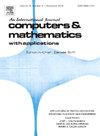Error analysis of the moving least square material point method for large deformation problems
IF 2.5
2区 数学
Q1 MATHEMATICS, APPLIED
引用次数: 0
Abstract
The moving least squares material point method (MLS-MPM) is widely used in large deformation problems and computer graphics, yet its error analysis remains challenging due to multiple error sources. We analyze moving least squares approximation errors, single-point integration errors, computation errors of physical quantities, and stability. The key to the analysis is deriving the single-point integration error for moving least squares shape functions. The main results demonstrate a significant correlation between error estimates and parameters such as node spacing, particle width, and particle density per cell. Numerical experiments further demonstrate that higher-order shape functions, constructed by combining basis functions with Gaussian, cubic spline, and quartic spline functions, significantly reduce errors, improving computational accuracy and reliability.
大变形问题的移动最小二乘质点法误差分析
移动最小二乘物质点法(MLS-MPM)广泛应用于大变形问题和计算机图形学中,但由于误差来源多,其误差分析仍然具有挑战性。分析了移动最小二乘近似误差、单点积分误差、物理量计算误差和稳定性。分析的关键是求出运动最小二乘形状函数的单点积分误差。主要结果表明,误差估计与节点间距、粒子宽度和每个单元的粒子密度等参数之间存在显著的相关性。数值实验进一步证明,将基函数与高斯函数、三次样条函数和四次样条函数结合构建的高阶形状函数可显著减小误差,提高计算精度和可靠性。
本文章由计算机程序翻译,如有差异,请以英文原文为准。
求助全文
约1分钟内获得全文
求助全文
来源期刊

Computers & Mathematics with Applications
工程技术-计算机:跨学科应用
CiteScore
5.10
自引率
10.30%
发文量
396
审稿时长
9.9 weeks
期刊介绍:
Computers & Mathematics with Applications provides a medium of exchange for those engaged in fields contributing to building successful simulations for science and engineering using Partial Differential Equations (PDEs).
 求助内容:
求助内容: 应助结果提醒方式:
应助结果提醒方式:


